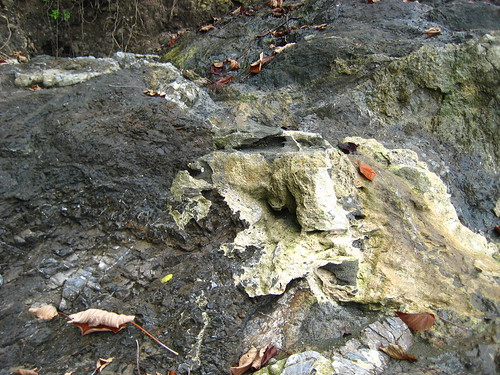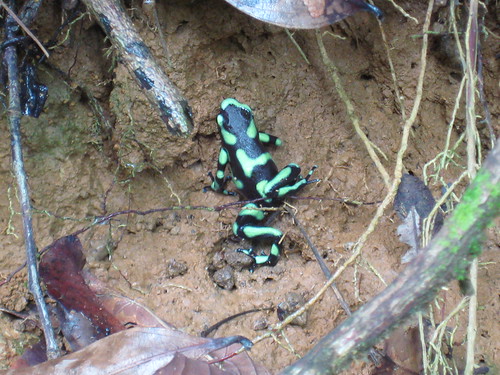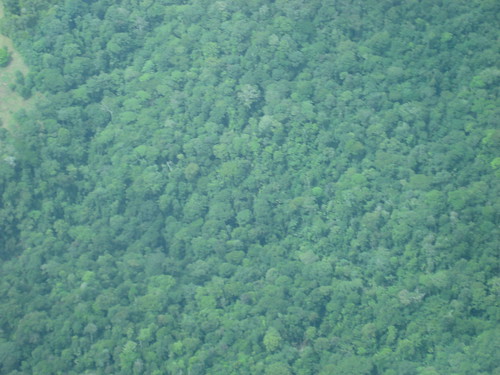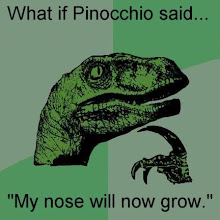Greenman3610 has a new video out showing that even if politicians don't want to believe it companies and private individuals have been slowly trying to become more efficient in their energy usage.
Monday, July 25, 2011
Tuesday, July 19, 2011
Geology of My Trip to Costa Rica

This article is a continuation of the series that I started a few days ago discussion several select topics in relation to my recent honeymoon to Costa Rica more specifically the Osa Peninsula. Now I am going to lead this article off by admitting that for the most part this topic seems to be under researched overall. There are a lot more personal observations in here than there are sources to peer reviewed published citations, which I am pretty upset about personally, so I do recommend you do your own research to find out more. I should point out that there are 3 sources (here, here, and here) that if I would have had access to them may have added some to the discussion here, so if you have read them feel free to post anything you know in the comments.
Overall Costa Rican Geology
The map at the top of the article was first published by the USGS in 1987. It has since been updated and digitized in 1996 by Paul G. Schruben, see larger version of the map here. So why am I using a map from 1987, the map is only a year younger than I am that should say something? Well the reason is that this is the only geologic map of the country that I could find so I am sure that it is slightly out of date. On another note here is the website for the Costa Rican Geological Survey.
Two things I notice right away just by looking at the map is that there is a lot of igneous rocks in the country and that there are not rocks visible on the surface that are older than the Jurassic. Both of these things exist for the same reason. When the continents first started rifting apart from the super continent of Pangaea North and South America were not connected, at least not in the same way they are today. This rifting because in the late Triassic/early Jurassic and the rates and directions of spreading varied in different parts of the Atlantic. This is why the oldest rocks are Jurassic in age. For millions of years the two Americas remained separated but eventually the Pacific Plate began to subduct under the North American Plate and the Caribbean Plate. This subduction caused more and more of Central America to be pushed up so for a bunch of volcanic islands to what we have in Costa Rica and Panama now, this initiated what is known as the Great American Interchange. According to discussions that I had while in country the Pacific Plate underwent a very shallow subduction this is what caused many of the volcanoes in the center of the country become dormant or extinct. These seems plausible but I don't know enough about the study in the area to be able to say for sure, I am going to admit here that Igneous and Metamorphic rocks were never my strong suit so I welcome anyone else to say if they know better.
Geology of the Osa Peninsula
 The Osa Peninsula and the Gulfo Dulce represent a very unique geologic set up compared to the rest of the country. A lot of travel brochures refer to Gulfo Dulce as a "tropical fjord" due to the great depth of the gulf and the steep drop-off to that depth as well as the surrounding land being mountainous. Fjord by definition cannot form in tropical environments because they need to be formed by glaciers, which this gulf was not, and they need to have more of a u-shape as well as having the mountain slopes forming right up to the edge of the water. But what explains the great depth?
The Osa Peninsula and the Gulfo Dulce represent a very unique geologic set up compared to the rest of the country. A lot of travel brochures refer to Gulfo Dulce as a "tropical fjord" due to the great depth of the gulf and the steep drop-off to that depth as well as the surrounding land being mountainous. Fjord by definition cannot form in tropical environments because they need to be formed by glaciers, which this gulf was not, and they need to have more of a u-shape as well as having the mountain slopes forming right up to the edge of the water. But what explains the great depth?This is actually a pretty simple answer the Osa Peninsula is composed primarily of basalt. Basalt is a rock that is typically associated with ocean floor rocks and differs from continental igneous rocks which tent to have more silica in them and as such are actually less dense than basaltic rocks. So the depth of the Gulfo Dulce is due to the fact that as the Pacific plate subducted under the Caribbean Plate the Osa Peninsula was pushed up on the Pacific plate side. So the gulf actually represents the spot where the Pacific plate is subducting and is just a continuation of the trench that runs along the Pacific coast of most of South and Central America. But why did the Osa Peninsula not subduct with the rest of the Pacific Plate?
A completely honest answer is that we (or maybe just I) don't know. This is one of the great things about science is that we can admit that but I can put through a couple of hypotheses that can eventually be tested. The first one is that the Osa Peninsula represents a spot where the Pacific plate has bent to such a high degree that it caused the Peninsula to be pushed up above water and eventually it will be subducted eventually. Now by itself I don't think this explains the Peninsula or we would expect to see a great many more islands like this following the boundary of the Pacific Plate. Another possibility is that for some reason the basalt that forms the rocks on the Osa Peninsula is less dense than the normal basalt. As I explained above silica rich rocks tend to be less dense than the basaltic rocks and running through the basalts visible on the beach were many many quartz seams. Quartz is made up of Silica and Oxygen and is a typical constituent of continental rocks, it is also the main constituent of most beach sands. This would have made the rocks less dense and more likely to but uplifted and less likely to be subducted which would cause the Osa Peninsula to stick up and eventually be accreted to the mainland of Central America. Now I will admit I like this last one better but it is honestly just a very basic hypothesis.
One more thing I hadn't noticed that there are supposed to be a lot of sedimentary rocks on the Osa Peninsula. Now while these break down before they can be seen on the surface and are likely just covering the basaltic rocks they aren't talked about much. Something you may notice in the picture that I posted at the start of this section is that yellow staining on the basaltic rocks, this picture was taken by the author and shows some of the rock visible on the Pacific side of the Osa Peninsula. Soil is thin in the area and most of these smaller streams don't carry much in the way of physical sediments what this yellow staining looked a lot like to me is travertine. This could be resulting from the few limestone rocks on the peninsula dissolving and the calcite reprecipitating on the rocks at the beach, if you want to know more about travertine look at my two posts on two of the caves in the National Park system, here and here. This post went far longer than I would have liked and there is another aspect I would like to cover that I can tie into another post so that is what I will try to do, also I should point out that I only just barely touched on some complicated topics so if you have any questions about any of that let me know. If you want to read a little bit more about this area geologically read this article from 2009 in Earth Magazine.
Saturday, July 16, 2011
New Twist on a Famous Image
Although it isn't exactly accurate SMBC has a new take on the famous progress of evolution. Make sure you click on it to appreciate the image fully.


Cell Phones
I have discussed a few times in the past the cell phones cause cancer idea, including a small rant in this post, but I think xkcd has it right in their comic from yesterday.


Friday, July 15, 2011
Costa Rica!!
 So as I mentioned in a previous post I recently got married, for our honeymoon my wife, still have a haven't gotten used to typing/saying that yet, and I went to Costa Rica [photo at left of a Green and Black Poison Dart Frog (Dendrobates auratus) by author]. There will be a couple of posts in the next few days about some things I found interesting/want to discuss about the country. I have two more posts that I have to finalize and I may be able to squeeze out one more but we will see. This post is going to serve more as an introduction to this little mini-series.
So as I mentioned in a previous post I recently got married, for our honeymoon my wife, still have a haven't gotten used to typing/saying that yet, and I went to Costa Rica [photo at left of a Green and Black Poison Dart Frog (Dendrobates auratus) by author]. There will be a couple of posts in the next few days about some things I found interesting/want to discuss about the country. I have two more posts that I have to finalize and I may be able to squeeze out one more but we will see. This post is going to serve more as an introduction to this little mini-series.As with everything I try to do here I will avoid politics as much as possible. This will be for 2 main reasons, the first being I just try to avoid politics in my posts as much as possible anyway (although I am sure some people may feel that my discussion on global warming is political and unfortunately it has to be to some degree) and the second and most important is that I know nothing about politics in Costa Rica. This all being said some of the topics I discuss will touch on some potentially political topics.
One other thing I am going to try to avoid is making this sound like an advertisement for the resort that my wife and I stayed at. This will be the only post that I will explicitly state the name of the hotel, as well as link to their website, and this is because I am going to openly admit upfront that I did not see much of the country so my posts will only be about the area that I know and I want to be honest with you about what I feel could be a potential bias*.
 So now that I am done with that (took much longer than I expected) lets talk a little bit about the country itself [photo at right taken flying over a forested area of Costa Rica by author]. Costa Rica is located in southern Central America south of Nicaragua and north, although more west since Central America makes a turn in Costa Rica, of Panama. The country is just a little bit smaller than the state of West Virginia in regards to square mileage (~20,000 sq mi/~51,000 sq km for Costa Rica to ~24,000 sq mi/~63,000 sq km) but it has more than double the population of West Virginia (~5 million for Costa Rica to ~2 million for West Virginia). As you can imagine this is a much greater population density for Costa Rica as compared to West Virginia but most of the population is located in one region of the county known as the central valley. This area is the area of the country where San Jose is located. This area should be great for farming due to the rich volcanic soil, see geology is important, while the areas outside of this used to be primarily rain forest which, as I will discuss in a future post, very quickly becomes poor farming environment. The country is highly mountainous, which for anyone who has driven through West Virginia will tell you is another similarity between these two places, and this can be explained by the geology of the area, which will be discussed in greater depth in a future post.
So now that I am done with that (took much longer than I expected) lets talk a little bit about the country itself [photo at right taken flying over a forested area of Costa Rica by author]. Costa Rica is located in southern Central America south of Nicaragua and north, although more west since Central America makes a turn in Costa Rica, of Panama. The country is just a little bit smaller than the state of West Virginia in regards to square mileage (~20,000 sq mi/~51,000 sq km for Costa Rica to ~24,000 sq mi/~63,000 sq km) but it has more than double the population of West Virginia (~5 million for Costa Rica to ~2 million for West Virginia). As you can imagine this is a much greater population density for Costa Rica as compared to West Virginia but most of the population is located in one region of the county known as the central valley. This area is the area of the country where San Jose is located. This area should be great for farming due to the rich volcanic soil, see geology is important, while the areas outside of this used to be primarily rain forest which, as I will discuss in a future post, very quickly becomes poor farming environment. The country is highly mountainous, which for anyone who has driven through West Virginia will tell you is another similarity between these two places, and this can be explained by the geology of the area, which will be discussed in greater depth in a future post.My wife and I only spent one night in San Jose we spent most of our time in another part of the country. The area we stayed in was known as the Osa Peninsula, which surprisingly has a very crappy Wikipedia page. The peninsula is the furthest southwestern point of the country and my wife and I stayed on the tip of the peninsula. This part of the country is one of the most important ecological places in the world and according to everyone I talked with while there as well as a couple of other sources (which I can't find now) call the area one of the most ecologically diverse places on the planet if you want to know more about the ecology of the Osa Peninsula I recommend the Wikipedia page on the Corcovado National Park.
We stayed at a hotel named Bosque del Cabo. This hotel was interesting in that our room was an individual little cabin like structure that sat right near the drop off for the Pacific Ocean. The overlook provided the opportunity to watch plenty of birds as well as a chance to see all four of the monkey species that live in Costa Rica. This hotel, like many others on Osa Peninsula, is what is known as an ecolodge. The ecolodges down there try to be as much a part of nature as they can while still providing luxury amenities. Most of the power was created using solar power, some appears to have been made using hydroelectric sources as well, each cabin had their own individual solar water heater, the resort is tries to recycle as much of their waste as possible, and most importantly the forest, with the exception of right around the cabins, is allowed to grow free which allows the chance for the wildlife to live free nearby and actually get extremely close to the cabins. If you are looking for a place to stay if you visit Costa Rica I recommend finding an ecolodge on the Osa Peninsula it is worth the cost, and I will give them one more shout out but I personally recommend Bosque del Cabo.
With the basic introduction out of the way, far longer than I wanted to write as well, the rest of the posts in this series will focus on topics that are more commonly seen on this blog, things like geology and conservation, so I hope you enjoy the mini-series.
*I will admit I don't think bias is the proper word choice but I can't figure out what would be so you will have to deal with my really narrow vocabulary!
Wednesday, July 13, 2011
Dinosaur Eggs and Creationism
Potholer54 continues to feature his Golden Crockoduck award nominees, this one deals with dinosaur eggs and how they somehow show that a global flood occurred.
Statistics are Important!
While his videos always take a more medical approach to science the practice is a science so I have always enjoyed C0nc0rdance's videos. This particular one shows why a scientist needs to have a basic understanding of statistics. It also shows why single studies, like the Wakefield MMR paper, don't prove anything and why I was so upset with the World Health Organization (WHO) when they issued their statement saying that cell phones might cause cancer, that was until I saw they had it in the same category as things like coffee aka if they do it will be hidden in the noise anyway (although they probably don't since as far as physics are concerned there is no mechanism, ok I will get off this topic now). Anyway enjoy!
The Earth is NOT facing a mini-ice age!!!
So the past few weeks have been pretty hectic for me as I had to drive about 26 hours to get home, I got married, went on our honeymoon, and then had to get back here to west Texas so sorry about the lack of posts. I have a couple of posts in the works so just hold on and we will get back to some new content. For the time being I am getting caught up on some YouTube videos so there is a chance there will be a lot posted here over the next few days. This one is from Potholer54 taking to task all of the people who are using a recent study on sun inactivity to say that we are entering a mini-ice age.
Subscribe to:
Posts (Atom)
